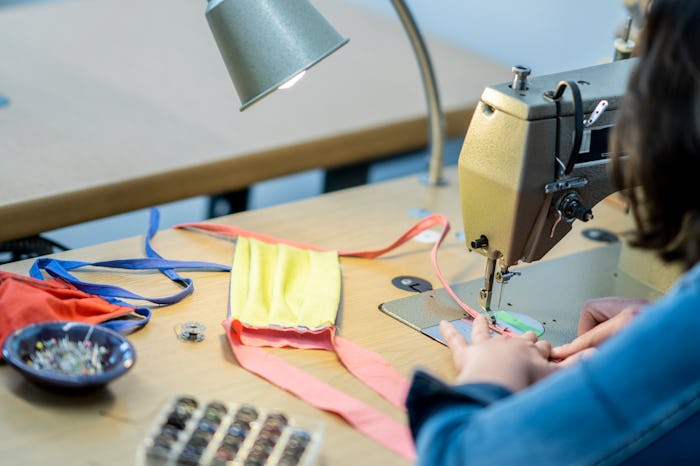News

A New Study Says These Are The Most Effective Types Of Face Masks
As more states mandate the wearing of face masks in public, more and more people are wondering which cloth face coverings offer the best protection. After testing various materials and styles, researchers at Florida Atlantic University (FAU) have discovered that the best non-medical face mask to wear for protection against the novel coronavirus is one stitched with two layers of quilting fabric.
"Loosely folded face masks and bandana-style coverings provide minimal stopping-capability for the smallest aerosolized respiratory droplets," reported the study, which was published Tuesday in Physics of Fluids. "Well-fitted homemade masks with multiple layers of quilting fabric, and off-the-shelf cone style masks, proved to be the most effective in reducing droplet dispersal."
To find the most effective mask, researchers from Florida Atlantic University's College of Engineering and Computer Science used flow visualization, a process of making flow patterns visible. This process involved simulating the jet of respiratory droplets released during a cough and sneeze using a mannequin, laser light sheet, and a mixture of distilled water and glycerine. Masks were placed on the mannequin for testing, allowing researchers to observe and map the droplets' path.
Researchers tested multiple non-medical masks in total, all of which were masks they believed to be readily available for purchase by the general public. They included a simple folded mask, a single-layer bandana covering, a non-sterile cone-style mask found in most pharmacies, and a homemade mask made by stitching two layers of cotton quilting fabric with a thread count of 70 threads per inch together.
In testing a cloth mask folded per recommendations from the The Centers for Disease Control and Prevention (CDC), researchers found there was "notable leakage of tracer droplets through the mask material" and along the top edge of the mask. The single-layer bandana covering was found to be "substantially less effective" than the folded mask in stopping the jet and the tracer droplets produced during a cough or sneeze. When wearing the non-sterile, cone-style mask, the flow of droplets was "impeded significantly" compared to the folded cloth mask but "noticeable leakage" was still observed along the top edge of the mask.
Overall, the most effective mask proved to be the one made by stitching two layers of cotton quilting fabric together. "We observe that the mask is able to arrest the forward motion of the tracer droplets almost completely," the study read. "There is minimal forward leakage through the material, and most of the tracer-escape happens from the gap between the nose and the mask along the top edge. The forward distance covered by the leaked jet is less than 3 in. in this case."
But researchers have said their study doesn't just shed light on which mask might be best, but also shows why adhering to social distancing and face mask recommendations is so important. "In addition to providing an initial indication of the effectiveness of protective equipment, the visuals used in our study can help convey to the general public the rationale behind social-distancing guidelines and recommendations for using face masks," Dr. Siddhartha Verma, the study's lead author and assistant professor in FAU's Department of Ocean and Mechanical Engineering, said in a statement.
While the CDC has recommended people leave a minimum of 6 feet between themselves and others, researchers found that when not wearing a mask, jets of respiratory droplets could travel up to 12 feet. "These observations, in combination with other recent studies, suggest that current social-distancing guidelines may need to be updated to account for the aerosol-based transmission of pathogens," the study noted.
If you think you’re showing symptoms of coronavirus, which include fever, shortness of breath, and cough, call your doctor before going to get tested. If you’re anxious about the virus’s spread in your community, visit the CDC for up-to-date information and resources, or seek out mental health support. You can find all of Romper’s parents + coronavirus coverage here.
Study referenced:
Verna, S. "Visualizing the effectiveness of face masks in obstructing respiratory jets" Physics of Fluids 32, 061708 (2020); https://doi.org/10.1063/5.0016018